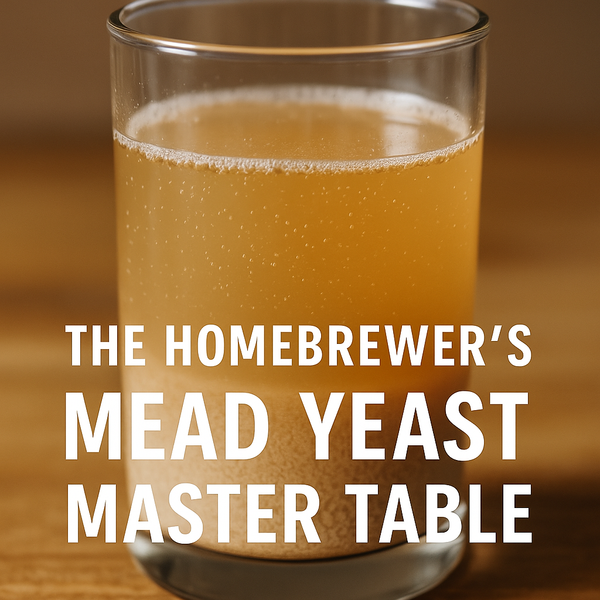Brewing Water Series - Tasting Minerals, Sensory Evaluation

In February 2015, I brewed Brülosopher’s Best Brown Ale which naturally turned into a series of experiments. The intention was to ship beer off to Marshall from Brülosphy.com for evaluation, and that twisted into preparing some bottles, doctored, for sensory evaluation. I kept a set of the evaluation beers as part of my sensory education to review with a BJCP Certified judge. I am merely Pending... counting the days till September for the tasting exam.
The beers were bottled from a keg that had been conditioning in my kegerator, and I had recently changed gas lines and installed ball lock connectors with a check valve. The result was that all of the beers were flat… meaning we both had to recap after priming. In the time this took - Marshall’s evaluations drifted from my intended format (which is my fault). Their general impressions are noted at the end.
All of the findings below should be considered anecdotal and opinions! Much more testing needs to occur, systematically to determine the impact of differing mineral profiles.
The Procedure
Brülosopher’s Best Brown Ale was brewed on February 12 to 11 gallons. The water profile used was intentionally different than Marshall’s normal profile, and used epsom salt to provide the required sulfate. The details were discussed in the previous Brewing Water Series article.

Based on the finished water profile above, three new profiles were developed with the focus on pushing sulfate, chloride and magnesium each to their respective “flavor threshold” in Bru’n Water Spreadsheet (the exception being sulfate which only reached 214 ppm). Each beer was assigned a symbol, the appropriately salts were added to 100 ml of finished beer and stirred to dilute. Salts were carefully measured out on a jeweler’s scale (calibrated) and accurate to +/- 2 mg. 50 ml of these solutions were added to the appropriate bottles and then each bottle was topped up using a beer gun from the keg. The result was 4 beers in the flight: base beer, gypsum beer, epsom beer and calcium chloride beer.
Note: Because the salts were added to finished beer they did not have the opportunity to go through the mash and boil process. The bottles were eventually bottle conditioned and it is likely that some of the salts may have precipitated. I did not adjust for pH in the finished beers, which may have impacted flavor and mouthfeel. However, since we pushed the ion’s flavor thresholds, the results were three distinct beers versus the baseline beer.
| Calcium | Magnesium | Sodium | Sulfate | Chloride | SO4/Cl | |
| Base | 41 | 20 | 8 | 111 | 51 | 37:17 |
| Epsom | 41 | 33 | 8 | 163 | 51 | 163:51 |
| Delta | - | +13 | - | +52 | - | |
| Gypsum | 84 | 20 | 8 | 214 | 51 | 214:51 |
| Delta | +43 | - | - | +103 | - | |
| CaCl | 65 | 20 | 8 | 111 | 93 | 37:31 |
| Delta | +24 | - | - | - | +42 |
In the table above, you can see the delta for each mineral in the estimated water profiles.
My friend Neil Spake (BJCP Certified) and keeper of scottishbrewing.com sat down with me for the evaluation. We judged these blindly by symbol (I did not know which beer was which without my notes after two months). I explained the purpose to Neil after the first beer to beer evaluation. After the sensory analysis, we went back and ordered by preference.
Generally, the bottled beers did not hold up very well. In the process of dissolving minerals and dosing, I oxidized the beer that went into the bottle. While it was detectable, it was not overwhelming - yielding a wet paper aroma and slightly stale taste that was not in the freshly tapped beer. This is an issue that needs to be eliminated in future testing.
Our tasting notes are below:
| Matt | Neil | |||
| Base | Aroma | Biscuit, Toast, low hop aroma, no off aromas. Sweet Malt, light caramel | Grainy, Bready, Biscuity Malt with slight caramel/toffee. No hops | |
| Flavor | Toasty Munich character, medium toffee, Firmly bitter, but Malt forward. Dry clean finish. | Lovely bready lightly toasty grain, definite brown ale character, low carb, medium body, medium bitter finish, dry, dark grain, some hop bitterness | ||
| Appearance | Brown, Bright, low Head, white, falls quickly. Low carbonation. | Medium brown, Slight garnet hues, very clear, thin head, light tan, doesn't persist | ||
| Overall | Great beer aging well. Carbonation low, likely from growler fill and rest. | Classic American Brown Ale. Great recipe. | ||
| Epsom | Aroma | Low malt, wet paper, sweet smelling, cracked pepper spice, musty | Some paper (oxidation?), subdued malt, biscuit/cracker-like, no hops | |
| Flavor | One note malty sweetness, toast on the finish, soft mouth feel. No mineral character. | Malt Sweetness, well balanced, more toasty/roasty flavors like the base. Caramel a little more subdued, slight salty aftertaste | ||
| Appearance | Low carbonation, dark brown with red highlights, Bright. White head falls quickly. Medium body. | Medium brown, low garnet hue. Clear, thin off-white head, doesn't persist | ||
| Overall | Of the three - closest to the base sample. Acceptable. | softer mouthfeel | ||
| Gypsum | Aroma | Dry cracker, very low aroma, some wet paper (oxidized?) No Roast or toast | Dry/stale bread, cracker-like aroma, no hops, no esters. Slight paper/cardboard (oxidized?) | |
| Flavor | Malt forward with a weird sharpness, toast and dark biscuit lingers | Thinner body, mouthfeel medium to medium low. Salt in finish. Malt sweetness, better balance than circle but lacks the toastiness of base | ||
| Appearance | Bright brown and red, deeper color than Base, white creamy head falls quickly. Low carbonation | Medium brown, slightly deeper hue than base. Thin off white head, loose and doesn't persist | ||
| Overall | Creamier mouthfeel than Base, much softer. Muddled malt character | - | ||
| CaCl2 | Aroma | Biscuity, malt sweetness, very low hop aroma. No roast or toast | Biscuity/Bready malt but more subdued compared to base beer. Definite mineral (sulfate?) character. | |
| Flavor | Sweet, malty, stone fruit/plum, soft and round, less sharp than Base | Softer, sweeter malt character, more caramel/toffee than base. Picking up salt (sodium) in finish, bitterness, dark grain bitterness nearly gone. | ||
| Appearance | Brown, bright, creamy white head falls to lace. Low carbonation | Medium brown, slight garnet, very clear, think week light tan head doesn't persist. | ||
| Overall | Mellow compared to Base. Much softer mouthfeel and much less robust complexity in malt. Muddled | Softer on palate but salty finish, less roast, more caramel sweetness and lower bitterness |
Conclusions:
We found the beers to be very different. While it is difficult to account for the problems I created in bottling and later conditioning, the magnesium beer really stood out - where the sulfate beer was completely muted and tasted the most salty. The chloride beer was certainly the sweetest and most malty. I think the tasting notes really speak to the qualities brought to the table. Being a brown ale, the base beer really featured layers of malt and toast, with a little sweetness that complimented the bit of hops. So while there are perhaps few empirical conclusions we found that, at least in this case, the epsom did the least harm to an already very good beer. Remember that the base beer already had a moderate magnesium content, but also was better carbonated, resulting in a dry crisp finish that was missing in the evaluation beers.
The Aroma and Flavor were the most changed; the color difference likely due to darkening from oxidation. In particular, the mouthfeel from each beer was unique.
Epsom Beer: Sharpened up the toast character, reducing complex layers of malt, toast and caramel. At 40 ppm, there was a clear mineral/salt character that Neil detected, so staying well below that level is necessary. I did not pick up the salty character, but trust Neil's palate.
Gypsum Beer: Expecting a sharper roast and hop character, we were surprised at the muddled and muted malt and hop character. This was the most oxidized of the bunch, probably from the difficulty in dissolving gypsum.
Calcium Chloride Beer: Rounded malt character and much “sweeter” on the palate. Where the Epsom beer seemed to amp up roast/toast tones, this was a muddled mess of soft malt. Nothing stood out and the toast character was gone.
Coming back to the base beer, of which we enjoyed several after the evaluation, I am very happy with the result of using epsom rather than gypsum to achieve the desired sulfate levels. Trying to pick out the role that magnesium plays is very difficult, but it adds a slight nuance to help presenting layers of malt flavors, and leaving some room for the hop bitterness and slight hop flavor and aroma. Of course, the higher level of carbonation plays a role in enhancing the dry finish, despite a fairly high FG.
Notes from Marshall of Brülosophy.com: He and a few friends approached this like a triangle test and singled out the Calcium Chloride beer as the odd beer out. They noted a much fuller and richer malt character in the Calcium Chloride Beer, where they felt the Epsom and Gypsum beers were noticeably sharper with a lingering bitterness.
I plan to return to this experiment with a pale beer, perhaps something with a very soft starting point. This will let me isolate from the base profile and more completely evaluate specific flavor contributions. A very frustrating element here is that it is impossible to eliminate the secondary -ions, with increased magnesium comes elevated chloride or sulfate. A mildly hoppy ale should allow simpler flavor notes to be easier to sense.




